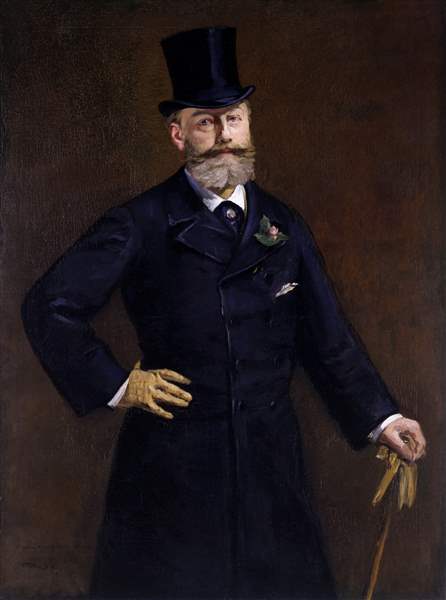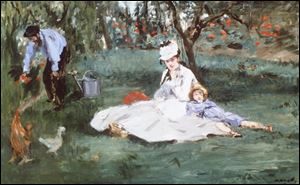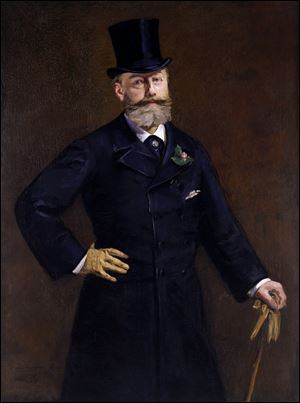
Face to face with Manet
Museum show features artist's portraiture
10/7/2012
Portrait of M. Antonin Proust, 1880.

Detail from the Monet Family in their Garde at Argenteuil, 1874.
First of all, it's "MAN-aa," not "MONE-aa," a similarity that struck even Edouard Manet.
"Who is this Monet whose name sounds just like mine and who is taking advantage of my notoriety?" asked Manet in 1865 at the pretisgous Paris Salon exhibit.
Manet was 33, and 25-year-old Claude Monet, he of water lilies and Impressionism, was just beginning to make a name for himself.
The boundary-pushing Manet, who earned the moniker “father of modern art,” provided inspiration and moral support to the slightly younger group of Impressionists as they flexed their aesthetic muscles. He painted scenes of everyday life, which the Impressionists did, but didn’t paint outdoors much, as they were fond of.
“What a painter!” exclaimed fellow Frenchman Paul Signac, 21 years Manet’s junior. (Signac’s Grand Canal, Venice, 1905, is owned by the Toledo Museum of Art.) “He [Manet] has everything, an intelligent mind, an impeccable eye, and what a hand!”
Said Paul Gauguin: “Painting begins with Manet.”
Opening today and continuing through Jan. 1 is Manet: Portraying Life, a beautiful and handsomely hung show of 39 paintings and 30 period photos and books in the museum’s Canaday Gallery. It was organized over five years by museum staff in conjunction with their counterparts at the Royal Academy of Arts, London, where it will travel in the new year. It’s the first exhibit to zero in on Manet’s portraits, which comprise about half his body of 400 works.
Walk across the short bridge to the Canaday and look left at a blown-up print of an enchanting woman in operatic costume: Portrait of Emilie Ambre as Carmen (1880). Manet painted this stunner fairly quickly with an unusually generous amount of red.
“It’s luscious,” said Larry Nichols, the museum’s William Hutton senior curator, European and American painting and sculpture before 1900. “There’s an approachability to these paintings.” With today’s constant clicking of images on phones pointed at oneself or others, and digital pocket cameras, portraiture is a far greater part of life than it’s ever been, Nichols noted. And, as it was for Manet and his subjects, it’s a self-conscious exercise: how do others perceive me and how do I perceive myself?
Time of change
Born in 1832 and financially secure with an inheritance, the stylish Manet could paint his heart’s desire, pursuing his vision of landscapes, bouquets, and la vie en Paris, rafting his subjects in ways that differed from the realistic Old Masters he’d studied as a boy. His was a looser, colorful brush, focused more on atmosphere and less on detail. His chameleon stylings, sometimes seeming to take their cue from the spirit of his subject, pointed the way to abstraction.
Modernity, a word attributed to Manet’s dear friend, the writer Charles Baudelaire, was infusing all aspects of Parisian life. The city was a destination for Europeans and Americans who came for culture, fashion, art, and the best medical training. Its very look was changing with the construction of long boulevards, bridges, and train stations. There was political upheaval, expanding industrialization, terrific literature, vast poverty.
For Manet, 1863 was a watershed year. His father, and a friend, the painter Eugene Delacroix, had recently died, stinging his mind with thoughts of mortality. He married his long-time love, a piano teacher from Holland named Suzanne, his most frequent model. She had an 11-year-old son, Leon; what’s not known is whether Leon (also a Manet model) was sired by Edouard or Edouard’s father, a Parisian judge.
At the same time, Manet was setting off fireworks in the art community with two bold paintings of nude women. Scandalous then and still provocative, Luncheon on the Grass (not in this show), depicts two unclothed women picnicking with two fully dressed men: one woman bathes in a stream, the other, sitting on a blanket, challenges the viewer with a straight-on gaze as if to say, “What?”
Wrote Manet: “Personally, I am not greatly interested in what is said about art. But if I have to give an opinion, I would put it this way: everything that has a sense of humanity, a sense of modernity, is interesting; everything that lacks these is worthless.”

Portrait of M. Antonin Proust, 1880.
Portraiture
He painted friends and family, writers such as Emile Zola and Irish poet George Moore; politicians (Georges Clemenceau), and artists including Monet with his young family in their garden, and the beautiful brunette with soulful eyes, Berthe Morisot, who married Manet’s brother Eugene when she was 33.
In the large charmer The Railway (1873), Manet’s model Victorine Meurent and a little girl dressed for a summer party are outside an iron gate of a steamy train station.
What hung in the Manet bedroom? A serene image of a pleasingly plump, middle-aged Suzanne, hands crossed on her lap, sitting in a garden (Mme. Manet in the Conservatory, 1879, not in this show). Another of Suzanne in a pink dress holding her beloved cat, Zizi, was sold to their friend, painter Edgar Degas, who shared Manet’s distaste for being labeled an Impressionist.
His portraits can be grouped into formal poses and informal slices of life: a boy on a bike, a strumming Spanish guitarist, a game of croquet, Suzanne at the piano. He understood the potential impact of photography on portraiture and sometimes asked his subjects to give him one of their “visiting cards,” small photos used as calling cards. A 17-minute video loop in the gallery shows 197 such cards he collected.
Stinging criticism
Yearning for approval from the establishment, Manet entered paintings in the Paris Salon contest, with mixed success, from the late 1850s to 1882. But he also liked challenging the system and trying new methods. In years when his work was rejected from the Salon, he invited people to see it in his studio or rented a building to show his work. He even showcased a rejected painting in a store window.
Critics could be vicious, including the powerful writer Theophile Gautier, who’d once smiled upon young Manet. But in 1870 Gautier wrote: “None of the promises of his early years having been realised... each exhibition seems to prove that M. Manet has resolved to die wholly unrepentant, led astray by a false doctrine and imprudent praise.”
“He was hurt badly by criticism. That’s why he painted Emile Zola, as a thanks for the support he gave him,” said Nichols.
Indeed. In the center of the gallery is a large painting of a young, bearded Zola seated at his desk with detail that could be termed shameless self-promotion: a booklet on the desk bears Manet’s name; it’s Zola’s essay defending Manet’s art after critics had ripped him to shreds. And hanging above the desk is a likeness of Manet’s famous nude, Olympia, stretched out and locking eyes with the viewer. There’s Japanese art too, popular at the time.
Perhaps his most distinguished and traditional portrait is of Antonin Proust (1880), given to the Toledo museum in 1925 by Edward D. Libbey, museum founder. Proust (not the writer Marcel Proust, born in 1871) was Manet’s boyhood chum and wrote about him extensively. A journalist and eventual politician, Proust served as the Minister of Fine Arts for two months, during which time he bestowed the prestigious Legion d’honneur on Manet, then sickly with a degenerative neurological disease brought on by syphillis thought to have been contracted in his youth. The illness claimed him at the age of 51 in 1883.
The Proust hung at the 1880 Paris Salon along with a canvas of an eager chap in a cafe, flirtatiously engaging an attractive woman, Chez le Pere Lathuille (1879). Just last month, Nichols learned that the Belgian-owned painting had been approved for loan to Toledo, and the two are displayed next to each other.
Collaboration
Nichols arrived at the museum 20 years ago and realized it “needed to organize a great local show.”
In 2005, he discussed the possibility of a Manet exhibit built around the Proust portrait with then-museum director Don Bacigalupi, who gave it thumbs up. Nichols submitted a written proposal to Bacigalupi in August, 2007 and within weeks, learned that MaryAnne Stevens of the Royal Academy of Arts, London was also planning to spotlight Manet. He contacted her and in October, met her in England. Stevens’ idea was to stage an overview of Manet’s work; Nichols’ aim was portraits, an angle that hadn’t been done. As they talked, the synergy of collaboration grew increasingly attractive.
“It’s more logical to collaborate,” said Nichols. “There’s just so many Manet shows that can happen.”
Figuring it would take three to four years to put it together, they each pinpointed chunks of time that would fit into their museums’ exhibition calendars and complement the other’s.
IF YOU GO
Manet: Portraying Life
Through: January 1, 2013
Admission: $8 ages 23 through 64; $5 for others; no charge for children 5 and younger. Audio tour: $3. Free admission for members ($55 individual, $35 over 65, $75 family.) A combination ticket (admission to Manet as well as the Made in Hollywood photo exhibit) is $12.
Information: 419-255-8000 and toledomuseum.org.
With a list of desirable paintings, they traveled together to museums over the next two years: Lisbon, Budapest, Paris, Milan, Munich, Hamburg, Birmingham, Oslo, Copenhagen, and cities throughout the United States, meeting with curators, many of whom they knew, to explain their project. They followed up with a formal written request for a loan. They also met with individuals who owned Manets.
“You have better success when you go in person,” he said.
Loan negotiations continued in 2010 and 2011. Donors were sought for sponsorships. (Major sponsors are Block Communications, Inc., owner of The Blade, and BP-Husky Refining LLC.) Ultimately, 16 overseas museums and private collectors lent paintings as did 19 North American museums and private collectors.
Nichols and Stevens then undertook the companion book called a catalogue, soliciting essays from art historians and writing much of it themselves. The 213-page Manet: Portraying Life is available in the Museum Store, $55 hardcover, $40 softcover.
Then there was the matter of insurance. The cost to insure the 37 paintings that were shipped in specially made crates to Toledo (each accompanied by a human caretaker who oversaw delivery and hanging and who will return for packing up and the trip to London) would be astronomical.
Museum staff submitted a lengthy application to a federal program that backs the art in the event of loss or damage up to $1.2 billion, called the Arts and Artifacts Indemnity Program, administered by the National Endowment for the Arts. It was approved.
How is Manet appreciated financially, 129 years after his death? A self-portrait when he was a handsomely bearded and well-dressed 46 year old, sold for $29.5 million in 2010.
Contact Tahree Lane at tlane@theblade.com or 419-724-6075.